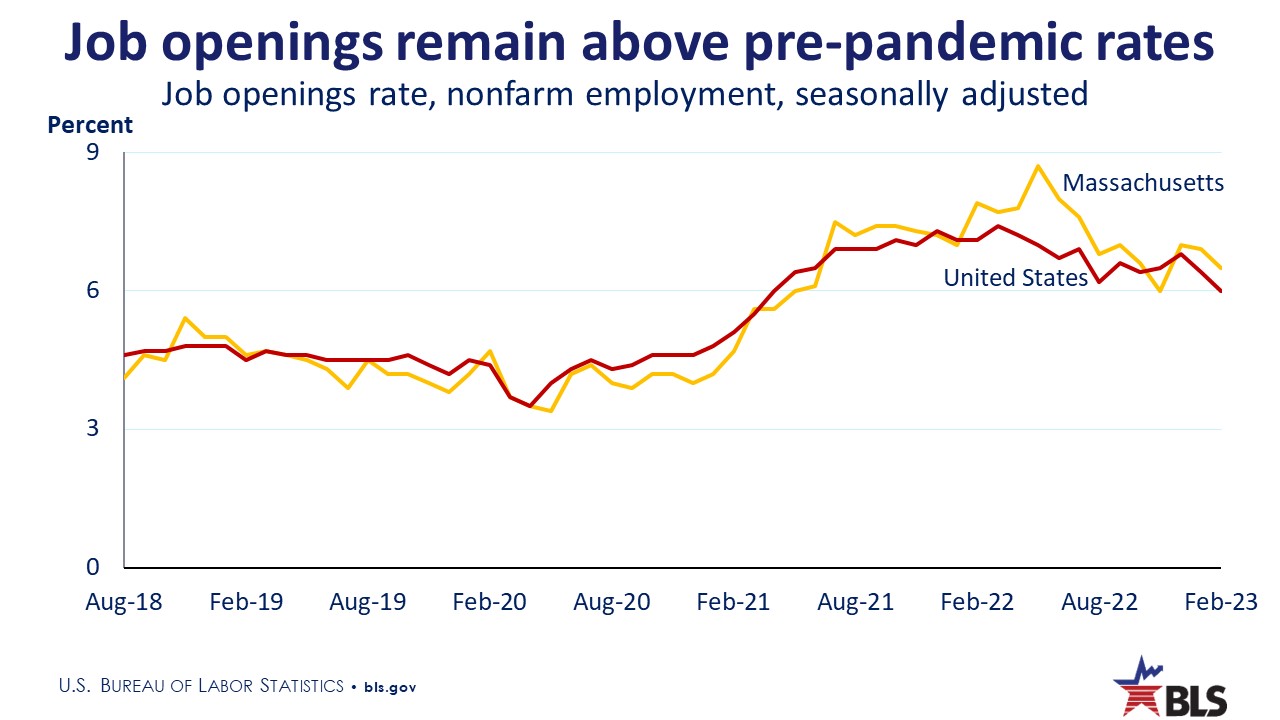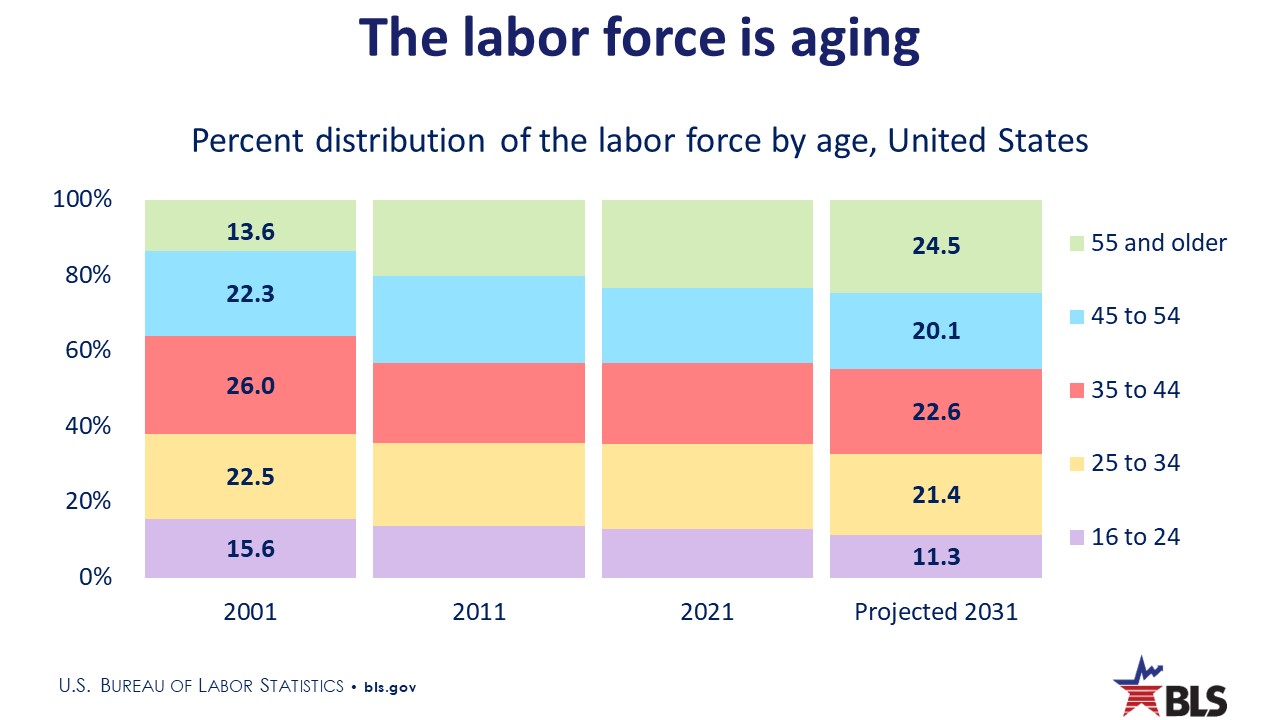How a flexible workforce approach helps organizations grow and thrive
 7 strategies for increasing your talent pool and employee retention rate
7 strategies for increasing your talent pool and employee retention rate
The future of work is – in a word – flexible. Companies are fiercely competing for talent. Job openings remain above pre-pandemic levels and are higher in Massachusetts than in the country. Broadening your hiring strategies and taking a flexible approach that creates a positive employee experience will give your organization the upper hand in attracting and retaining top-quality employees.
Flexible work arrangements play a critical role in job satisfaction for both men and women and are a major reason for steadily increasing job satisfaction, according to the Conference Board’s annual job satisfaction report. “These results reveal that once workers are paid competitively, a strong workplace culture is the most important factor for keeping workers,” the Conference Board’s principal researcher of human capital Allan Schweyer said. A strong company culture – which, for example, is reflected on Indeed and Glassdoor company rankings – can also be a differentiator when it comes to attracting talent.
Flexible work options are effective at enticing workers to change jobs across most major industries: manufacturing, transportation, healthcare, education, and service. This holds even for employees who must work onsite. Employees who work in jobs that have to be performed in person rank flexible start and end times, a compressed workweek, and choice over the hours they work as their most valued options (June 2022 Gallup Survey).
A tight labor market is the new normal
A confluence of demographic factors means that the tight labor market will persist for years. During the pandemic, many baby boomers retired sooner than they would have otherwise. According to the Federal Reserve, these retirements account for about 2 million of the 3.5 million labor shortfalls. At the same time, the younger workforce is smaller than the generations ahead of it.
The share of workers under age 34 will decrease from 38.1% of the workforce in 2001 to 32.7% in 2031. Also, job openings are above pre-pandemic rates as U.S. Bureau of Labor Statistics Regional Economist Bruce Bergman reported at the recent New England Employee Benefits Council (NEEBC) Summit and Trade Show. "The long-term demographic trend of an aging population is contributing to a slowdown in projected labor force growth, and that suggests continued difficulties for employers in hiring and retaining workers.”
7 strategies for increasing your talent pool and employee retention rate
Hiring and retaining employees will be an ongoing challenge. Companies will need to rethink their talent pipeline, hiring strategies, and job and workplace requirements. Adopting a flexible workforce approach will help your organization grow and thrive. Here are 7 surefire strategies:
Strategy #1 - Broaden your company’s appeal
Given the continuing decline of younger workers, organizations seeking to broaden their talent pool can do so by increasing their appeal to younger as well as frequently overlooked, but valuable, sources of employees:
- Ethnic and racial minorities
- Older people
- Parents of young children
- Veterans
- Neurodiverse and physically disabled
- Geographically disbursed
How do you do this? Use the strategies that follow.
 |
||
| Bruce Bergman from the Bureau of Labor Statistics, Sandra Borders from the Commonwealth of Massachusetts, Yaosca Chimurenga from Robert Half, and Wen Fan Lead Researcher for the 4-Day Week Global Trial discussed how flexible work arrangements help companies attract and retain employees at the recent NEEBC Summit and Trade Show. |
Strategy #2 - Report diversity goals and progress
Research shows that a diverse workplace is good for the bottom line. Companies with a diverse workforce are 35% more likely to realize greater financial returns than their non-diverse counterparts. People from different backgrounds have a variety of life experiences and see the world in unique ways. Multiple perspectives increase creativity, innovation, and problem-solving (Forbes).
Companies seeking to attract and retain a diverse workforce benefit by publicly reporting their diversity goals and progress toward them. Prospective and current employees pay attention to this commitment and transparency. Approximately 64% of candidates research a company online before applying for an opening: 1 in 3 will not apply for a position at a company that lacks diversity (Glassdoor).
The Commonwealth of Massachusetts is a leader in publishing its diversity dashboard. This interactive and transparent tool allows website visitors to research the workforce demographic makeup including full- and part-time status and historical trends. The diversity dashboard includes age, gender, race; service length in years; veteran participation; and employees with disabilities representation.
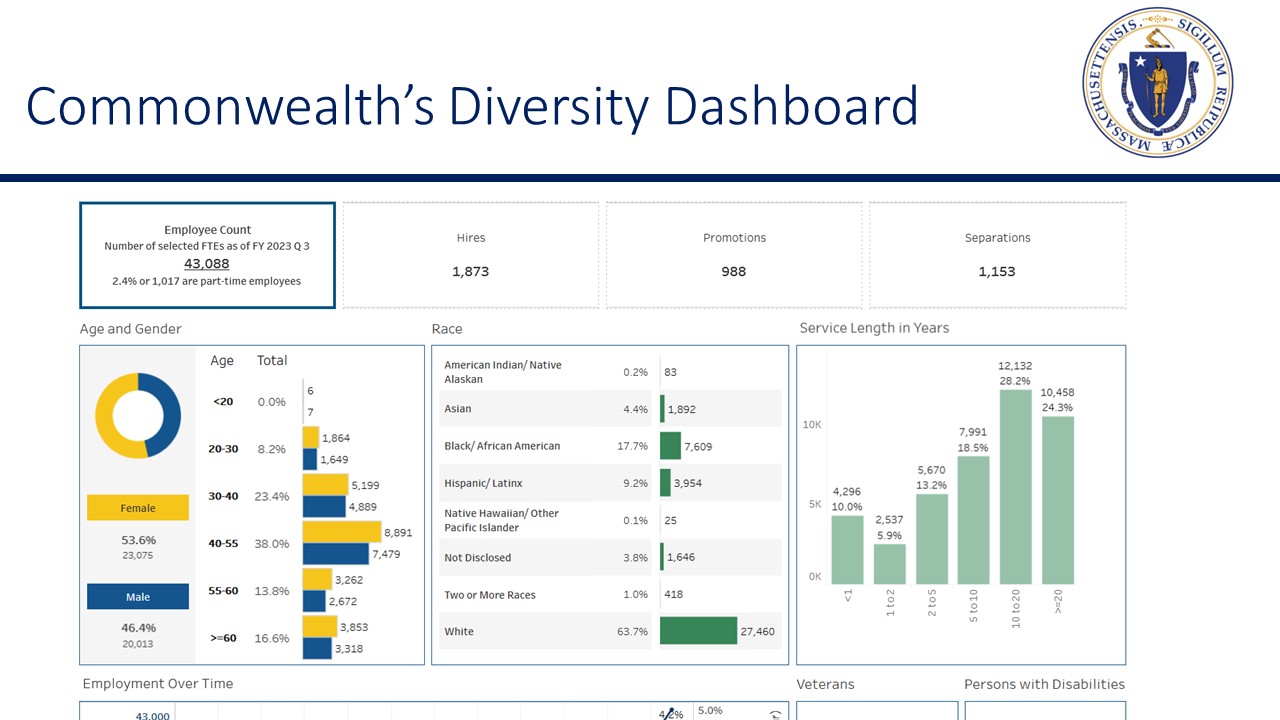
“The diversity dashboard holds us accountable to progress we committed to making. It also helps foster current employee advancement throughout the Commonwealth,” Commonwealth of Massachusetts Human Resources Division Chief Diversity Officer, Sandra E. Borders, MSM, PHR said at the NEEBC Summit.
Strategy #3 - Offer part-time employment
Offering part-time opportunities is an effective strategy for attracting and retaining older workers and parents, especially those with young children. “Companies that have part-time options and job sharing can coax retired workers and parents who require childcare back to work,” Robert Half’s Boston and Cambridge Branch Director Yaosca Chimurenga said at the Summit.
Older workers are a knowledgeable and reliable group of employees, but many are looking to work part-time. With employees ages 55 and over expected to increase to 24.5% of the workforce by 2031 (Bureau of Labor Statistics), overlooking this pool of employees’ desire to work part-time is short-sighted at best.
Baby boomers are self-sufficient, rational decision-makers, hard workers, and realistic, according to a recent Indeed Insight article. “People over the age of 55 account for 25% of the population who are seeking part-time employment, up from 22% in 2017, and they’re a large labor pool source,” Bureau of Labor Statistics Bergman said.
 |
||
|
Offering part-time opportunities is an effective strategy for attracting and retaining |
Flex time, where employees negotiate which days of the week and which hours of the day they work is also gaining steam. "Flexibility in areas such as work scheduling is key to attracting and retaining older demographics as well as women, who must juggle jobs and child care responsibilities more often than their male counterparts. Employers that aren't focusing on retention and recruitment of women are jeopardizing their long-term talent pools at a time when they can ill-afford to do so,” Indeed’s Chief Economist Svenja Gudell opined in a recent SHRM article.
Part-time work allows new parents, typically women, to cobble together affordable child care while allowing more time with their children. The greater the representation of gender diversity, the higher the likelihood of outperformance (McKinsey), and companies that offer part-time options will increase the number of women in their workforce.
Strategy #4 - Move toward a four-day workweek
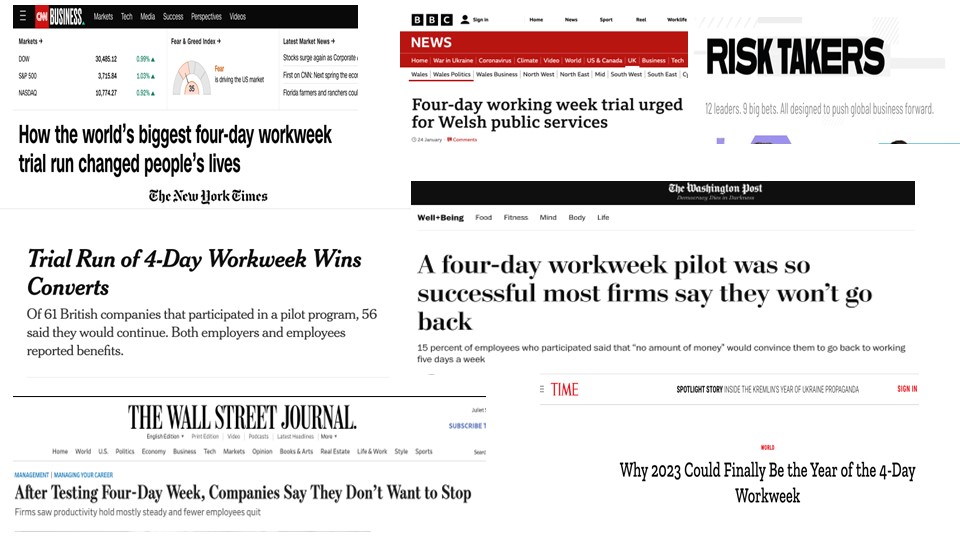
A four-day workweek is wildly popular across all generations, income levels, and partisan groups according to a spring Washington Post-Ipsos poll. The 4-Day Week Global Trial, with the first round of results published in December 2022, showed multiple benefits for employers and employees:
- Burnout – 68% of employees reported less burnout
- Lower stress levels – 32% reported a reduction
- Reduced fatigue, improved sleep, and improved mental health
- Increased job and life satisfaction – 46% and 57% reported an increase, respectively
- Reduced resignation rate – down 3.4%
- Reduction in sick days – 30% less than the previous year
- Increased company revenue: up 8.14% over the course of the trial for 16 companies that provided adequate data — weighted for the size of the business — while a separate 20 companies saw revenue climb more than 37 percent from the same six-month period a year earlier.
“The 4-day Week Global Trial was an overwhelming success. More than two-thirds of participating companies in the first two trials definitely plan to continue this model with another 26% planning to continue. We anticipate that more companies will consider this option due to the high number of unfilled positions and resignation rates; quiet quitting; and employee burnout and stress,” 4-Day Week Lead Researcher and Boston College Associate Professor Wen Fan said.
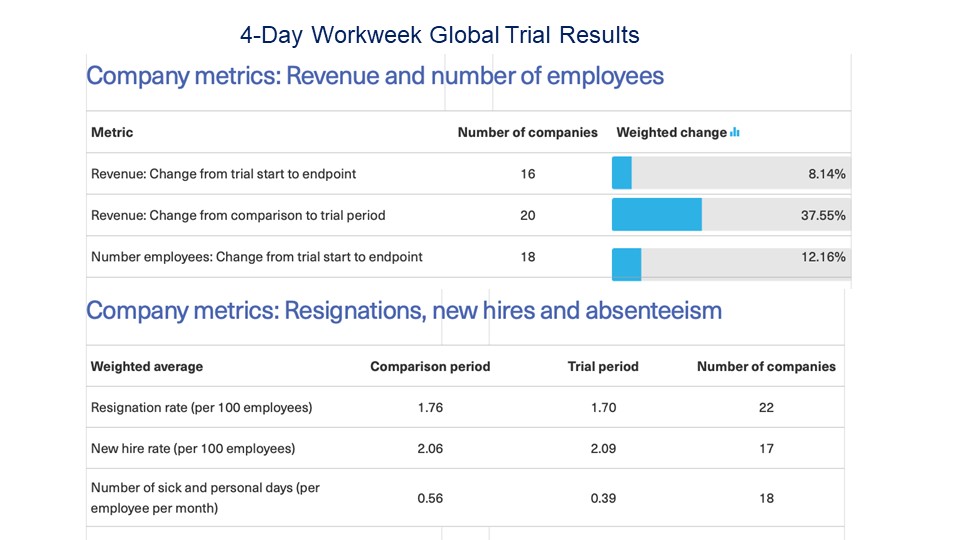
The 4-Day Week Global Trial aimed to meaningfully reduce the number of hours worked (by approximately eight hours per week) without any reduction in pay. Almost 97% of employees wanted to continue with the arrangement. Over 14% said no amount of money would incentivize them to return to a 5-day workweek.
A compressed workweek gives employees more personal time and alleviates the stress associated with being on call every day. The Washington-Ipsos poll showed interest in a compressed workweek: seventy-five percent would prefer working four 10-hour days versus five eight-hour days. However, 73 percent would rather work five days a week at full-time pay than four days for less pay.
Hurdles to 32-hour, 4-day workweeks without pay reduction include concerns about staffing, lower productivity, increased costs, and complex changes to operations. Legislators in Massachusetts recently proposed a bill that would support a two-year pilot of a four-day workweek. Participating businesses would be eligible for tax credits under the program. “Preparation is needed for a smooth transition to a 4-day workweek. Employers need to engage employees in the process, be transparent about their goals, and give employees the confidence that their voice matters,” Lead Researcher Fan advised.
Strategy #5 - Adopt or maintain a hybrid workforce
Although many companies are offering fully remote or hybrid work arrangements, some want workers to return to the office full-time. They should proceed with caution. According to a recent Robert Half survey, 54% of employees want a fully remote position, and 55% plan to seek a job with a hybrid schedule. Remote and hybrid options led to a 48% increase in retention; a 41% improvement in morale; and a 37% increase in the candidate pool.
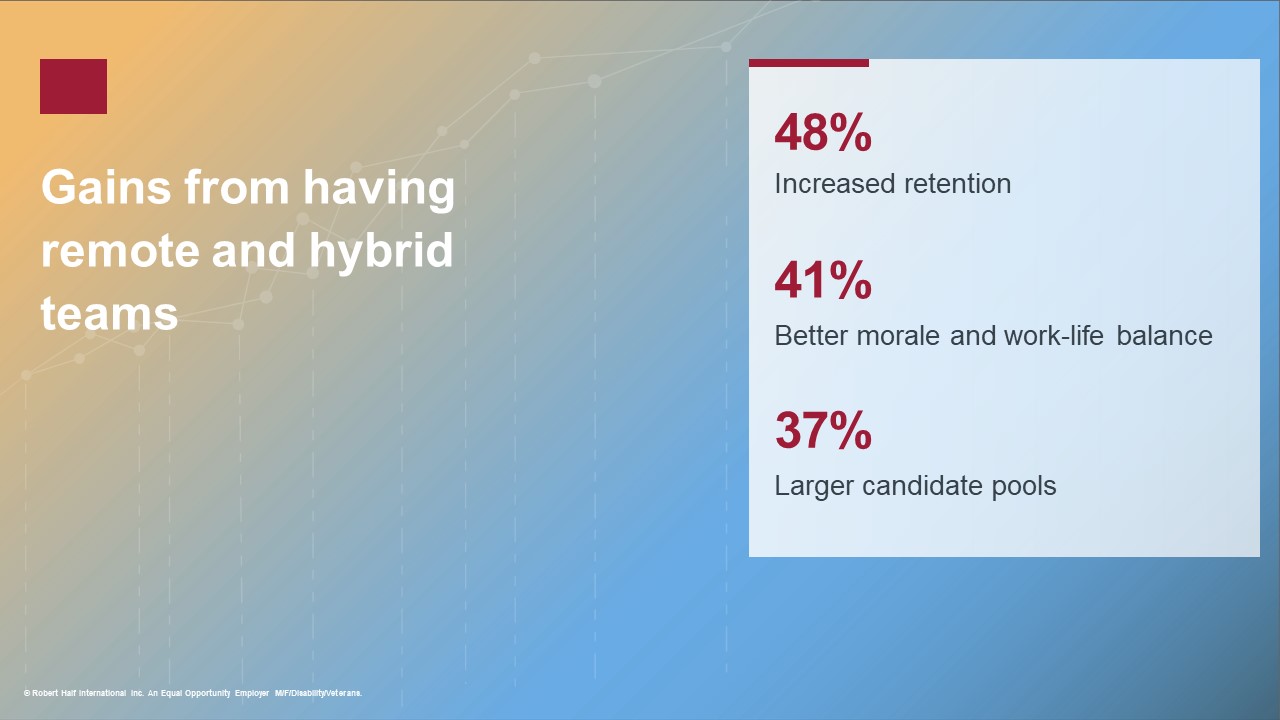
Younger workers expect work-from-home options. Since the pandemic, many employees across all generations don’t want to return to the office due to the time-consuming, emotionally taxing, environmentally degrading, and expensive nature of the daily commute.
“Companies should evaluate which is more important – getting employees into the office or attracting and retaining employees. If you’re looking to increase your candidate pool, offering fully remote will allow you to hire employees from outside your geographic area. Flexible work options are the new name of the game,” Robert Half’s Chimurenga pointed out.
Women are more likely to work in a hybrid work environment and prefer it. A February survey conducted by The Business Journals found 50% of women worked in hybrid offices compared to 44% of men, and 82% of women (compared to 75% of men) preferred a hybrid work arrangement. If companies mandate a return to the office, it could disproportionally affect one class of workers.
“We’re seeing a high level of state employee interest in continuing to work from home. We’re moving toward hybrid arrangements to ensure collaborative work can be done in person. Our job postings highlight hybrid work arrangements to appeal to a wide audience,” the Commonwealth’s Borders said.
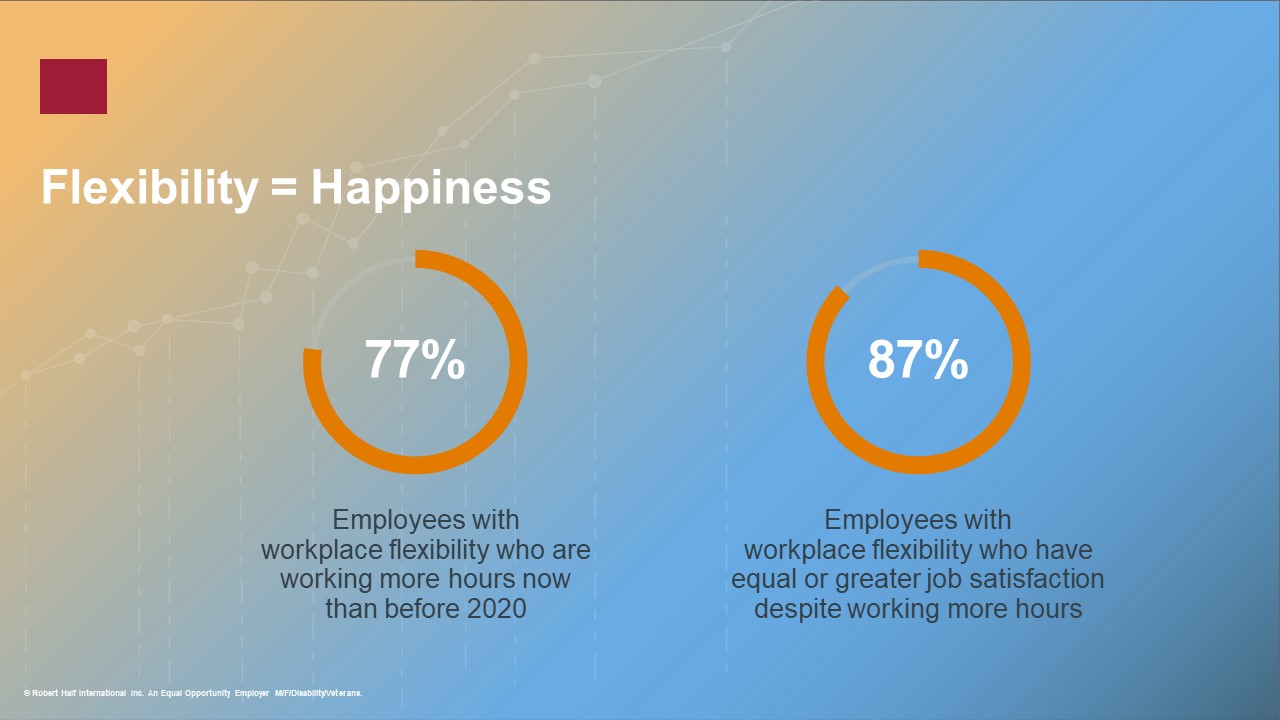
“Work is still being done when workers are at home, and many are more productive without the distractions of the office. Having workers in the office for team-building events, community service days, team meetings, and special events help build camaraderie,” Robert Half’s Chimurenga concluded.
In addition to her recommendations, you might consider:
- Scheduling onsite team and client meetings only on certain days of the week.
- Continuing to use communication channels (e.g., virtual, slack, email, phone) to touch base and update the team.
- Holding the line on meeting times – stick to an hour ideally – two hours maximum.
- Sending monthly employee newsletters or CEO updates to keep employees in the loop on company news.
- Focusing on individualized projects for remote work.
Strategy #6 - Institute workplace accommodations
Individuals with neurodiverse and physical disabilities are often overlooked as a viable pool of employees. People with disabilities account for about 12% of the civilian population according to the Bureau of Labor Statistics. Some workplace accommodations may be necessary, but there are numerous resources for companies interested in hiring and retaining employees with disabilities. “Companies should look at the many abilities of people with disabilities,” New England Council CEO Jim Brett said at the NEEBC Summit.
Remote work created new work options for those with disabilities who were unable to travel to a physical office. "We've seen in the data that people with disabilities have been able to enter the workforce in much higher numbers when employers offer remote work," Indeed’s Gudell pointed out.
 |
||
|
Individuals with neurodiverse and physical disabilities are often overlooked as a viable pool of employees. |
Companies seeking to hire neurodiverse employees may need to consider a long workday to allow for more breaks, situating the employee’s desk at the perimeter of the workspace near an exit, and implementing a sensory-friendly environment, which could include dimmer lighting, less visual clutter, and sound-reducing panels on the walls. “Neurodiverse individuals often have strengths in attention-to-detail, systematic thinking, memorization, and concentration, particularly on projects they’re interested in. These allow them to excel in a wide range of jobs including data analysis, information technology, accounting, automotive technology, and manufacturing.,” League School of Greater Boston’s Director of Neurodiversity & Community Inclusion Lindsay Thelin Wagner, MOT, OTR said.
The Commonwealth’s Massachusetts Rehabilitation Commission and the Massachusetts Commission for the Blind offer multiple resources for organizations seeking to hire and retain employees with disabilities. Mass Rehab assists employers with finding qualified, prescreened job candidates. The Commission for the Blind can assist employers with securing needed technological services like screen readers. Both agencies and Operation ABLE, which helps older workers find employment, provide prospective employees with job search training and support.
Strategy #7 - Provide multi-language communications
Companies that don’t look for opportunities to engage employees in languages other than English will be missing out on a valuable group of employees and clients. Fostering a workplace that’s welcoming to non-native English-speaking workers adds new perspectives and improves service to your customers.
About one in ten U.S. residents speak a language other than English at home (U.S. Census Bureau). Spanish-speaking employees are the fastest-growing workforce cohort representing 18.3% of the 2021 workforce and are projected to increase to 21.5% in 2031 (U.S. Bureau of Labor Statistics). Your company will benefit from improving external communications to include non-English speaking communities.
Providing employee communications in popular non-English languages boosts employees’ understanding of their workplace and benefits as well as enhances the company’s culture. Does your Intranet have employee communications in the most popular spoken languages? Have you worked with your benefits carriers to identify opportunities to increase multi-language communications? Which internal materials should be available in Spanish or other non-English languages?
When I was the Communications Director at the Group Insurance Commission, we distributed new hire and open enrollment communications in a variety of languages. I collaborated with Spanish-, Vietnamese- and Cantonese-speaking employees to proof these materials and ensure they were easy to understand. This effort helped to build our team spirit and satisfaction.
Act now to effectively compete for talent
The pressure to find and keep employees is not going to let up. Competing for the talent you need to grow your business requires a flexible workforce approach. Adopting these seven strategies is a win-win for your company, its culture, and its workforce. Twenty-nine percent of companies plan to adopt ways of working changes in 2023 (Gallagher). Don’t get left behind.
Cindy McGrath, Chief Marketing Communications Consultant, Strategic MarCom
Email: [email protected]; website: www.strategicmarcom.com
LinkedIn: https://www.linkedin.com/in/cindyemcgrath


